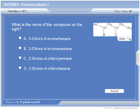Organic Nomenclature I
| Topic Review on "Title": |
IUPAC Nomenclature of Alkanes and Alkyl Halides
The first ten alkyl prefixes must be learned before beginning to name any organic compound. Meth is for one carbon. Eth is for two carbons. Prop is for three carbons. But is for four carbons. Pent is for five carbons. Hex is for six carbons. Hept is for seven carbons. Oct is for eight carbons. Non is for nine carbons. Dec is for ten carbons. The prefixes for identical groups are mono, di, tri, tetra, penta, hexa, hepta, octa, nona, and deca. Mono is rarely used in organic chemistry. The halogen prefixes are fluor, chlor, brom, and iod. Review the IUPAC rules again. Find the longest continuous carbon chain and circle it. Use Aane@ for alkane, Aene@ for alkene, and Ayne@ for alkyne. For alkenes and alkynes, number the chain so that the multiple bond has the lowest possible numbers. For alkanes, number from whichever end that gives the substituents the lowest possible combination of numbers. Give the location of each substituent with a number. Use numerical prefixes if more than one identical group is present. Use Ayl@ on alkyl prefixes and Ao@ on halogen prefixes. Alphabetize the groups. For alkenes, use cis if same group is on same side or trans if same group is on different sides. Examples are given.
Common Nomenclature of Alkanes and Alkyl Halides
Carbons are classified by the number of carbons directly attached to them. A zero degree carbon is attached to zero carbons. A primary carbon is attached to one carbon. A secondary carbon is attached to two carbons. A tertiary carbon is attached to three carbons. A quaternary carbon is attached to four carbons. Name as an alkyl halide. Use all of the carbons in the Aalkyl@ name. Use the prefix An@ if the structure is a straight chain, with halogen on one end. Use the prefix Aiso@ if the structure contains two methyls on a CH, with the functional group on the other end. Use the prefix Asec@ if the halogen is attached to the secondary carbon. Only use if the total number of carbons is four. Use the prefix Atert@ if the halogen is attached to the tertiary carbon. Only use if the total number of carbons is four or five. Use the prefix Aneo@ if the halogen is attached to a carbon, and that carbon is attached to a tert-butyl group.
|
| Rapid Study Kit for "Title": |
| Flash Movie |
Flash Game |
Flash Card |
| Core Concept Tutorial |
Problem Solving Drill |
Review Cheat Sheet |
 |
 |
 |
|
| "Title" Tutorial Summary : |
Two types of nomenclature are used in organic chemistry B IUPAC and common. Before naming any compound, learn the first ten alkyl prefixes. The prefixes are as follows meth (1 carbon), eth (2 carbon), prop (3 carbons), but (4 carbons), pent (5 carbons), hex (6 carbons), hept (7 carbons), oct (8 carbons), non (9 carbons), and dec (10 carbons). Learn the prefixes for identical groups and the halogen prefixes. Know the rules for IUPAC nomenclature. The prefixes for identical groups are mono, di, tri, tetra, penta, hexa, hepta, octa, nona, and deca. The halogen prefixes are fluor, chlor, brom, and iod. Common nomenclature is used for simpler organic compounds. Examples are given.
|
| Tutorial Features: |
This tutorial provides the comprehensive coverage of the chapter with easy introduction and simple illustration. It features:
- Concept map showing interconnections of new concepts in this tutorial and those previously introduced.
- Definition slides introduce terms as they are needed.
- Visual representation of concepts.
- Use of colors to emphasis points.
- Easy-to-follow animations of stated rules of nomenclature.
- Examples worked out step-by-step throughout the tutorial.
- A concise summary is given at the conclusion of the tutorial.
|
| "Title" Topic List: |
Two Types of Nomenclature for Alkanes and Alkyl Halides
- IUPAC Nomenclature
- Common Nomenclature
IUPAC Nomenclature
- First Ten Alkyl Prefixes
- Numerical Prefixes for Naming Identical Groups
- Halogen Prefixes
- Rules
Common Nomenclature
- Classification of Carbons
- Rules
|
See all 24 lessons in college chemistry, including concept tutorials, problem drills and cheat sheets:
Teach Yourself Organic Chemistry Visually in 24 Hours |



